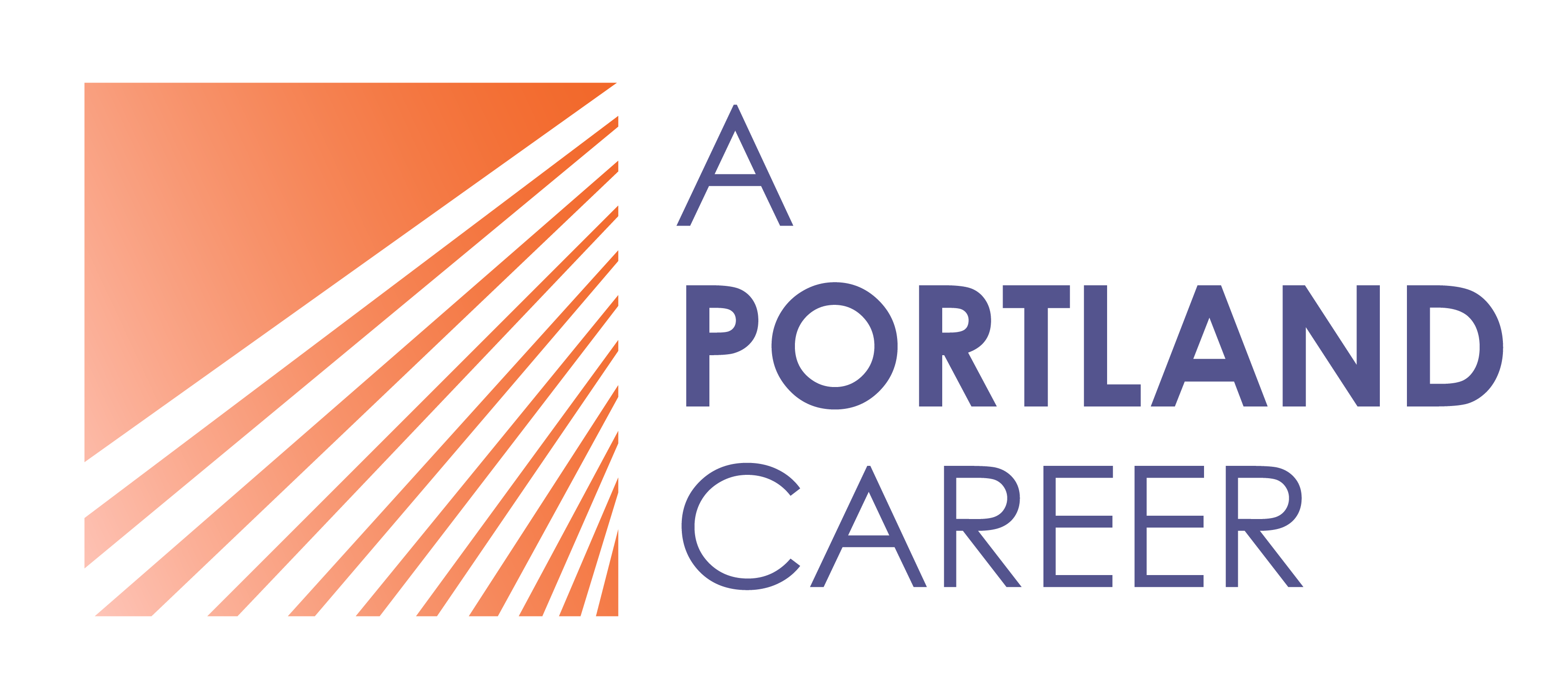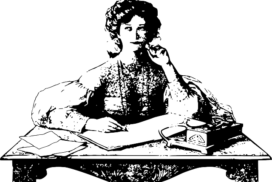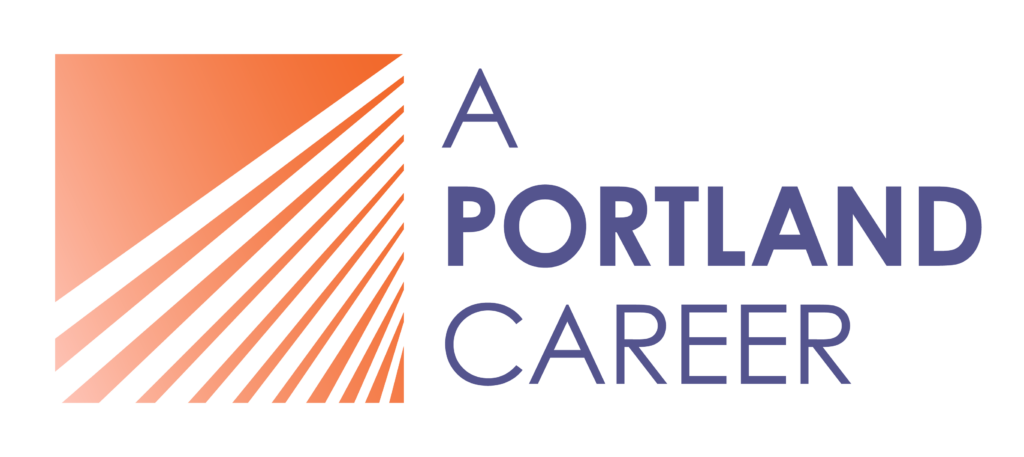Accomplishment statements power-up your the skills and experiences in your resume. Impress your potential employer with your brilliant accomplishments!
Plan your resume to showcase your most relevant skills and experience right up front to catch the eye of recruiters and ATS software.
Plan Your Resume and Land the Job Interview
By A Portland Career, and edited by Dan Hahn, M.S., and Suzie Sherman
Not getting interviews? Get in touch, and let’s work on your resume and cover letter.

Question: What is the point of a resume—what is its reason to exist?
Answer: You write a resume to land a job interview, period. A good resume is, simply put, a one-to-two-page advertisement of your education, skills, and work history, tailored to the job description you’re applying for. This article upgrades what you think you know about resume writing to ensure your resume obtains its one goal: landing you the interview.
An effective resume conveys who you are and what needs you will meet for your potential employer, and it must accomplish that quickly. Many career websites state job seekers have as little as six seconds to make an impression with their resume! Other sources suggest 30 seconds. Each resume you write (and each cover letter, for that matter) must be customized to the specific job to which you are applying. It must be legible to applicant tracking systems (ATS) and loaded with keywords from that specific job description and industry. This article gives you the bones to structure the most effective resume, packed with your most relevant information: from content to design, what to include, and what to toss!
Home → Helpful Articles → Resumes & Cover Letters → Plan Your Resume and Land the Job Interview
This is the first in a series of our articles on writing successful resumes and cover letters. Read ’em all:
- Plan Your Resume and Land the Job Interview (You are here!)
- Your ATS-Friendly Resume Must Have These 5 Components
- How to Identify Resume Keywords for Your Next Job Application
- Accomplishment Statements: A Powerful Way to Tell Your Career Story
- Our Complete Guide to Writing a Winning Resume
- How to Write a Kickass Cover Letter
Then, of course, you need to sit down and do some writing. Unless this is a big challenge for you, and you’re feeling stuck. In that case…
On This Page
Resumes and Cover Letters with Joanie Donnelly
Work with Joanie
In this video, Joanie Donnelly, our Resume and Cover Letter Expert, gives you some solid tips about crafting your resumes and cover letters, and talks about what it’s like to work with her on your application materials.
Customize your experience, anything from working collaboratively, to letting Joanie do most of the writing for you. Click the button to get in touch with Joanie!
Before you start writing your resume
You will write many different versions of your resume throughout your job search, and this article will make sure you’re prepared to write the best version of your resume for every job application. Before you decide on the structure and content for your resume, keep these guiding principles in mind:
- Target each resume to the specific job description and the specific employer. Each time you apply for a job, your resume should be modified. Yes, this is time-consuming, but it’s absolutely critical. By all means, keep a resume template for yourself with your contact information, work history, and professional accomplishments. Use this to cut and paste relevant content that you will use for each unique application process. But make sure to treat each resume as a custom job.
Yes, really! In our experience, customizing your resume to each job announcement you’re well qualified for results in a 30-40% interview request rate, much better than the average 16% reported by experts in the recruiting industry.
If you aren’t being asked to interview one out of three to four resumes you send out, get in touch with us and we’ll show you how to do it better.
- Focus on “what’s in it for them,” otherwise known as audience analysis. State what you have to offer the employer that meets their immediate needs. Potential employers don’t care too much about what you want. They need the specific knowledge and skills to match the job description they are posting. Show them that you are the solution to meet their need.
- Use keywords from the job posting and relevant keywords for the industry. Go through the job description and note each required qualification (for example, a specific programming language, an industry-specific software, a continuing education certification.) Then, match them to your most relevant skills and experiences to ensure you capture as many requirements as you can. “Keywords” are crucial in the era of “time=money” and ATS. Whether a human or a bot is scanning your resume, keywords are the deciding factor for whether your application will move on in the hiring process. The take-home is: the specific hard skills required for the job become the keywords that populate your resume.
Take it further: We go into more detail about deploying keywords in your resume writing process in our articles on Identifying Keywords and ATS-Friendly Resumes.
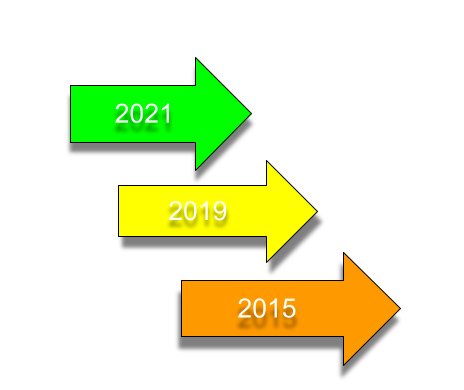
Choose the best type of resume to use
Now that you’re prepped for the writing process, you may be wondering, “How do I pull this all together?” First, strategize the best resume format for your current situation. You will need a different resume structure if you have vast, relevant experience in your field than if you are looking for entry-level work, or if you have gaps in your employment history.
The reverse chronological resume: the best option if you have recent, relevant experience
When your recent work experience is impressive and directly relevant to the target position, the reverse chronological resume is the best way to showcase it and catch the eye of the hiring manager. In this resume format, your work history is listed in reverse chronological order, so that the most recent jobs or experiences are near the top of the first page, immediately after your contact information, the job title, and other opening elements (see the discussion of sections of your resume below). Job titles and dates of your years of experience are emphasized, making your Experience section easily parsed by applicant tracking software.
The combination resume: the best option if you lack experience, are entering a new field, or have gaps in your work history
If there are gaps in your employment history, or you have a lack of direct experience, you might be tempted to use a functional resume, which emphasizes skills and downplays work experience or dates of employment. We advise against using this format: employers often assume that you could be hiding negative information. A lack of dates will also confound ATS software if your resume is being scanned (and, most likely, it is!)
If life experiences have intervened, making your career path a little less straight-forward, or if you are brand-new to a field and seeking an entry-level job, we recommend a hybrid format: the combination resume. This structure combines the skills-emphasis of the functional resume with the reverse chronological experience format, and resolves gaps in your timeline. In your combination resume, you should:
- Relate the job requirements of the open position with the experiences you do have: explain how they are similar or transferable skills, even though the work was in a different field
- Include life experiences in your chronology, along with work experience. If you were an at-home parent, a caregiver for a family member, or you were volunteering in a community organization, list these experiences, with dates, in your timeline. This real and valid life experience can help to account for the gaps in your work history that a hiring manager might have concern about.
Not exactly like riding a bike: If you haven’t looked for a job in a long time, all this talk about “keywords” and “ATS scans” and getting the reader’s attention in six seconds might be brand new information for you, and a bit overwhelming! If you haven’t been through a job search process recently, and you want help from real career experts, we’re here for you! Schedule an Exploratory Call today.
Design your Resume with Joanie Donnelly
Work with Joanie
In this video, Joanie Donnelly, our Resume and Cover Letter Expert, explains how to keep your resume design simple. It’s best for both the hiring manager and for automated ATS software to make sure your resume is legible, clean, and gets right to the point. If you want help writing your resume, get in touch with Joanie by clicking the button!
The content and design of your resume
Now that you have determined the most appropriate format for your situation, you need to decide what information to include, and what not to include. Choose the resume sections and content that highlight your most relevant skills for the position to which you are applying. Emphasize that relevant information with clean, legible design elements.
The top 1/3 of your resume: the most critical space
The top 1/3 of your resume is the most valuable real estate. Remember, you have six seconds to wow the reader and focus on what’s in it for them! Use your contact information and a professional profile to grab the reader’s attention, build credibility, and preview your top qualifications. Use keywords in your profile to help maximize your ATS score.
- Contact Information:
- Your full name
- The job title of the role you seek. Match the language for the role in the job posting you’re applying for: the job title is a keyword!
- phone number, and a professional looking email address (i.e. do not use your gamer email “bite.me@whatever.mail”).
- Your general location (you don’t need to include your full street address; it’s okay to say, for example, “Portland, Oregon.”)
- Your LinkedIn profile URL, or if you are in a creative field, Instagram or other social link with a portfolio of your work
- Your professional website URL if it showcases work that is relevant for the job
Professional Profile or Summary Statement: Don’t include an “Objective” in your resume – that’s a description of the job you are seeking (the employer already knows this!) Instead, provide a brief summary of what the employer gets if they hire you. Tell them how you match the qualifications and experience for the position using keywords and phrases in the job description, and the number of years of relevant experience you have. No more than five lines.
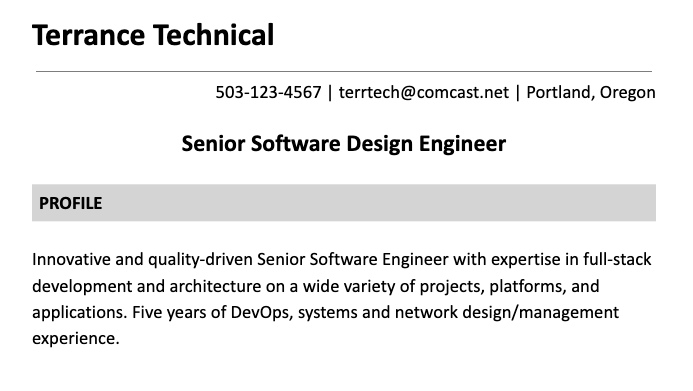
Keyword bank: If you are short on space, leave off the professional profile, and swap it out for a very concise keyword bank. Feature the job title of the position you are applying for at the top of the resume, and add one line of keywords (five to ten max) highlighting your most relevant qualifications for the job.
Choose the section headings of your resume
Next, evaluate the relevance of each potential resume section and determine the appropriate sections and order based on your experience and the employer needs. If you’re fresh out of high school or college, your Education section can be higher up on your resume, but if you have a lot of work experience, it’s best to feature that in the first section after your contact info and profile.
You don’t need to use all of these sections. Use the most relevant sections for the job description at hand.
- Experience: You can call this section Professional Experience or Work Experience, as well. We prefer the more open-ended section heading Experience because it can also include life experiences that fall out of the professional realm, such as caregiving, as discussed above. The Experience section is the most important, after your contact information and the job title at the top of the resume.
- List each experience, with start and end dates and job title, in reverse chronological order, most recent experience first.
- Use accomplishment statements, not just a dry list of job duties. Begin sentences and bullets with action verbs: Achieved, Improved, Trained, Mentored, Managed, Created, Resolved.
- Incorporate the job duties listed on the job description into your accomplishment statements.
- Technical Skills: if you are in a field with highly specific technical requirements for your job title, include a Technical Skills section and place it near the top!
- Education:
- Name of your high school (if you are still enrolled or a recent graduate only) college or vocational school
- location
- degree (if you received one)
- major or field you studied
- GPA: List a 3.5 or higher GPA if you’re currently in school, or recently out of school or college, and you’re seeking a job or internship where academic achievement is very relevant. Otherwise, leave it out.
- Extracurricular activities: list them only if they are relevant to the job.
- Certifications or Licensures: if you are in a field that requires specialized certifications or licensing, like a medical field, general contracting, a legal field, or any other type of work requiring certifications, exams, or boards, include a section specifically for this.
- Volunteer Service: use this section heading to list relevant volunteer work you’ve done, especially if you are applying for jobs in the nonprofit sector.
- Professional Affiliations: again, only include this section if your affiliations are relevant to the job you’re applying for, and you keep an active membership and play a role in the organization. For example, if you are a board member, or have planned relevant events.
Resume design: keep it simple
Be sure that the design elements you choose emphasize the most important, relevant content for the job you’re applying to. Make your resume as clean and legible as possible to both humans and ATS bots! Getting too creative with design, in this case, will dash your chances of landing an interview.
- Use white space, so your resume is easy to read. There should be plenty of white space between the main sections of your resume.
- Use the whole page, with no columns, and do not put your name and contact info in a header or footer: ATS software might not be able to read header info, and your resume will get lost in the shuffle.
- Keep the fonts simple and use only two, at most—one for the text and one for the headings.
- Use bullet points conservatively—too many are distracting to the eye and diminish the impact of the bullets. The general rule is no more than six bullets per position, or per experience you’re describing, and no more than three sentences per bullet.
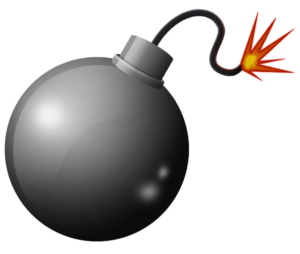
BEWARE these outdated trends that are still common mistakes in resume writing:
- “Resumes are one page.” Not necessarily—only if you have a short work history. Nevertheless, you do want to make sure the top third of your resume is dense with relevant information and keywords from the job description.
- “Use a header to show off your contact info.” This bears repeating: while it might look sharp, it’s best to skip the headers and footers. Word doc header formatting can trip up ATS software.
- “Begin with an objective.” Nope. Ditch “objective” and replace it with your Professional Profile: tell the employer what you can do for them, not what they can do for you!
- “Functional resumes are fine!” Hardly ever. Use a combination resume, as discussed above. Perhaps pull out a functional resume with just your skills and accomplishments in informal networking, but not for your job application.
- ‘“References available upon request” goes at the bottom of your resume.’ No. Provide potential employers your references when they ask you to.
- “List hobbies at the end of your resume.” Only if the hobbies are directly relevant to your target job. For example, if you are applying to an environmental nonprofit and you have experience working in a community garden, include that in your Volunteer Experience section, not just as a “hobby.”
Finishing touches for your resume
Here are a few tried and true tips to pay attention to once you’ve written your resume:
- Always run your resume through a spell and grammar check, then proofread it at least twice. Then read your resume out loud from top to bottom to ensure everything is clear and easy to say and understand.
- Make sure the language is positive and focused on what the employer needs.
- Submit your document in MS Word or PDF format, in most cases. These are the friendliest formats for both the human eye and ATS software.
- Save each version of your resume in a separate file. Doing so ensures you have a collection of your own resume templates with great accomplishment statements you can draw from to apply for future jobs.
- The copy of your resume you submit for the job should be named:
First Name, Last Name, Job Title, Resume (for example: Suzie Sherman, Content Marketing Associate Resume)
Final thoughts on planning your resume and landing the job
Be confident that if you follow this procedure to plan your resume, you will increase your chances of landing a job interview. The fundamentals to understand are that your resume is an advertisement highlighting the most relevant skills and experience you have to offer your potential employer, and your resume design should make what’s in it for them apparent on first glance of the top third of your resume.
Be sure to learn how to craft an ATS-friendly resume, how to write powerful accomplishment statements, and how to identify keywords for your resume in our resume and cover letter series!
Key takeaways
- A job resume is an advertisement telling your potential employer how you will meet their needs. Its one purpose is to land you a job interview.
- Before you set to writing your resume, make sure you know how to design it, and what content to include (and not to include).
- Be aware that most resumes will be scanned by an automated applicant tracking system (ATS), making legibility in design, plenty of white space, and the inclusion of keywords from the job description critically important.
- The top third of your resume is the most important part: catch the eye of the recruiter by letting them know what’s in it for them, and load this section with keywords that match the job description to your skills.
- The best resume format is the reverse chronological resume. If you have some gaps in your employment history, use a combination resume: focus on your accomplishments, and include a reverse chronology of the experience you do have.
- Select the most relevant section headings for the job you’re applying to.
- Showcase your most relevant skills with action packed accomplishment statements!
Related articles you might be interested in:
How To Identify Resume Keywords for Your Next Job Application
You need to know how to identify and incorporate resume keywords to write a winning resume that will beat applicant tracking systems (ATS). Here’s how.
George Santos’s Resume: Don’t Try This at Home
Representative George Santos teaches us how NOT to write a resume. First lesson: don’t lie through your teeth!
How to Write a Kickass Cover Letter with These 11 Essential Elements
Learn how to write your best cover letter with these 11 essential elements. Make a great first impression on your prospective employer, and land that interview!
